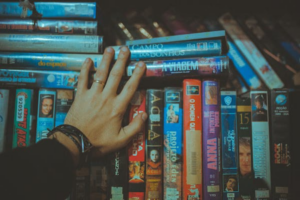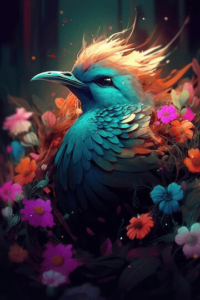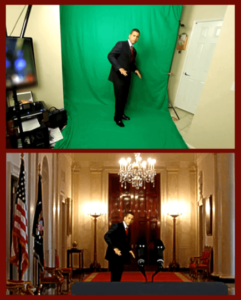Texturing in computer graphics is the art of imbuing 3D objects with lifelike visual details. This process involves applying 2D images, known as textures, onto the surfaces of 3D models. These textures serve as a visual map, defining attributes such as color, reflectivity, and surface bumpiness, collectively contributing to the object’s realism. Through techniques like UV mapping, the 2D texture is precisely aligned with the 3D object’s geometry, ensuring that colors and patterns adhere accurately. Texturing plays a pivotal role in creating visually compelling virtual worlds, enabling the simulation of a vast array of materials, from the roughness of stone to the sheen of polished metal, and is a fundamental tool in the artist’s toolkit for crafting immersive digital experiences. Dive into the world of texturing in 3D graphics.

What is Texturing in Films?
In filmmaking and computer-generated imagery (CGI), texturing refers to applying detailed surface characteristics to 3D models or visual effects elements to make them look more realistic. Texturing is crucial in creating visually compelling and believable movie scenes, particularly scenes involving CGI, animation, or special effects. Here’s a closer look at texturing in films:
Creating Realism
Texturing helps bring virtual or computer-generated objects and environments to life by adding depth and detail to their surfaces. This process allows filmmakers to simulate various materials, from skin and clothing to metal, wood, and natural landscapes.
Texture Maps
Textures are often created as 2D images, known as texture maps. These maps contain information about surface attributes like color, roughness, specularity (how shiny a surface appears), and displacement (surface deformation).
UV Mapping
To apply textures to 3D models, a mapping technique called UV mapping is used. UV mapping involves “unwrapping” the 3D model’s surface onto a flat 2D plane. This results in a UV coordinate map, where each point on the 3D surface corresponds to a point on the 2D texture map. By doing this, the texture map can be precisely applied to the 3D model, ensuring that the texture aligns correctly with the model’s geometry.
Complex Materials
In filmmaking, texturing can be especially complex when dealing with materials that have multiple surface attributes. For example, creating the appearance of weathered wood may require a combination of a diffuse texture for color, a specular map for shininess, and a bump map for simulating wood grain.
Special Effects
Texturing is vital for creating special effects in films, such as adding realistic textures to creatures, vehicles, or environments in science fiction or fantasy settings. It’s also used in compositing to blend CGI elements with live-action footage seamlessly.
Detail and Storytelling
Texturing contributes to the overall storytelling in films. Detailed textures can convey information about a character’s background, the historical context of a scene, or the mood and atmosphere of a particular setting.
Artistic Expression
Texturing is not only about realism but also about artistic expression. Film artists can use textures creatively to achieve a specific visual style or mood, whether a gritty and worn look for a post-apocalyptic world or a vibrant and whimsical texture for an animated fantasy.
Film texturing is a critical part of the CGI and visual effects pipeline. It involves applying 2D texture maps to 3D models to make them look realistic, convey information, and enhance a movie’s overall storytelling and visual aesthetics. Texturing allows filmmakers to bridge the gap between the virtual and real worlds, creating immersive and visually stunning cinematic experiences.
What Does A Texturing Artist Do?
Texture artists enhance the realism of computer-generated 3D models by adding details such as scales on reptile skin, reflections on surfaces, and wrinkles in fabric. They start with plain 3D models, meticulously painting textures until they resemble photographs. These artists may craft textures from scratch or use existing libraries and photographs, often from the film they’re working on. Once satisfied, they can replicate textures for use elsewhere. Texture artists find employment with VFX companies or work as freelancers. In smaller VFX firms, the roles of texturing and modeling artists may overlap, leading to combined job postings.
What’s a Texture Artist Good at?
Photography Skills
Knowledge of cameras and cinematography, coupled with technical expertise. Building a repository of photographs for use in the role.
VFX Program Proficiency
Mastery in using relevant software like Blender, Maya, Photoshop, Substance Painter, and ZBrush. Continuous efforts to enhance proficiency with these tools.
Artistic Acumen
Proficiency in understanding form, color, and texture, along with their harmonious interplay. Recognizing the elements that render an image lifelike in terms of lighting, color, composition, and perspective.
Organizational Aptitude
Efficiently managing work within production schedules, adept file management, and meeting project deadlines.
Collaborative Spirit
The ability to collaborate effectively with other VFX artists within the production pipeline, sharing resources and contributing to a cohesive workflow.
What are the Tools Used by Texturing Artists?
Professionals employ various software tools, including graphics software such as Adobe After Effects, Dreamweaver, Illustrator, and Photoshop. Additionally, they utilize 3D modeling, sculpting, and painting software such as Blender, 3ds Max, Maya, Mudbox, ZBrush, Substance Painter, Substance Designer, and Quixel. Learning how to model using free software is also an option. Check out “Build Your VFX Portfolio” for a list of available resources.
What is Texturing in VFX?
Texturing in VFX is pivotal in adding depth, realism, and visual detail to computer-generated elements within films and visual effects sequences. The application of meticulously crafted 2D texture maps defines the surface characteristics of 3D objects, environments, and characters, encompassing attributes such as color, reflectivity, roughness, and more. This meticulous artistry allows VFX artists to seamlessly blend CGI elements with live-action footage, achieving the desired visual aesthetics and storytelling impact in movies, television shows, and various media productions.
How is Texture Used in Film Music?
Texture in film music refers to the overall quality and character of the sound and music within a movie. It encompasses the layers, instrumentation, and arrangements used to create a scene’s auditory atmosphere and emotional impact. Here’s how texture is used in film music:
Emotional Impact
Texture is a powerful tool for conveying emotions and setting the mood in a film. Different textural elements can evoke a wide range of feelings, from tension and suspense to joy and nostalgia. For example, a lush orchestral texture with strings and woodwinds can create a romantic or sad mood, while sparse, dissonant textures may generate feelings of unease or suspense in a horror film.
Supporting Visuals
Film music often works with the visuals on screen to enhance storytelling. The texture of the music can complement the images and actions on the screen. For instance, a fast-paced, percussive texture can heighten the excitement and tension during an action sequence.
Character and Setting
Texture can help define characters and settings within a film. Each character or location may have its unique musical texture or motif. For example, a recurring musical texture associated with a particular character can help the audience identify and connect with that character’s presence on screen.
Narrative Pacing
Texture can influence the pacing and rhythm of a film. Slow, ambient textures can create a sense of calm and contemplation, while rapid, frenetic textures can build excitement and urgency.
Symbolism and Subtext
Film composers often use texture to convey subtext and symbolism. For instance, a recurring texture or musical motif may represent a hidden element of the story or a character’s inner thoughts and emotions.
Transition and Continuity
Texture can also serve as a bridge between scenes or help maintain continuity throughout a film. By using consistent musical textures or motifs, composers can create a sense of cohesion in the soundtrack, even if the settings and emotions of the scenes vary.
Genre and Style
Different film genres often call for specific musical textures and styles. For example, a sci-fi film may feature electronic and synthetic textures to create a futuristic atmosphere. At the same time, a period drama may use orchestral textures to capture the essence of a specific historical era.
Dynamic Range
Texture is essential for controlling the dynamic range of film music. Composers use varying textures to build tension and release it at key moments in the narrative, contributing to the overall dramatic impact of the film.
Texture in film music is a versatile and nuanced element that contributes significantly to the emotional impact, storytelling, and overall cinematic experience. It is a crucial tool for film composers to convey emotions, support visuals, and create a unique musical identity for each film.
What is the Purpose of Texturing?
Texturing enriches the visual quality and realism of objects, surfaces, or models in various fields, such as computer graphics, art, and visual effects. By applying textures, which are 2D images, onto 3D or 2D surfaces, texturing can simulate the appearance of real-world materials, add intricate details, convey emotions, and enhance storytelling. It allows artists, designers, and developers to create visually compelling and immersive experiences, making digital and artistic creations appear more authentic and engaging to viewers and users.
What are the Texturing Techniques used in Films?
Texturing techniques used in films, particularly visual effects (VFX) and computer-generated imagery (CGI), are similar to those used in other computer graphics areas but adapted to the film industry’s specific needs. Here are some common texturing techniques used in films:
UV Mapping
UV mapping is widely used in film production to apply textures to 3D models accurately. This technique involves unwrapping the 3D model’s surface onto a 2D plane, allowing artists to paint or apply textures in a 2D image editor before mapping them back onto the 3D model.
Projection-Mapping
In film production, projection mapping is sometimes used to project textures or images onto complex or moving 3D objects in real-time or during shooting. This can be especially useful for practical effects and set extensions.
Texture Painting
Texture artists in the film industry often employ digital painting techniques to create custom textures for specific scenes or characters. They use specialized software to paint textures directly onto 3D models.
Photorealistic Scanning
Film productions may use photorealistic scanning techniques for highly detailed textures to capture real-world objects or actors’ faces. This involves using high-resolution photography or laser scanning to create textures that closely resemble real objects.
Texture Libraries
Film studios often maintain extensive libraries of pre-made textures and materials for efficiency. These libraries contain a wide range of textures, including surfaces, materials, and patterns, which can be applied to various elements in a film.
Procedural Texturing
Procedural texturing is sometimes used to create dynamic and consistent film textures. This technique generates textures algorithmically, allowing for fine control over patterns, weathering, and surface details.
Normal Mapping
Normal maps are used in film VFX to add intricate surface details and fine bumps to 3D models without increasing their polygon count significantly. This technique enhances the realism of objects while keeping rendering efficiency.
Displacement Mapping
In high-end VFX, displacement mapping can be used to physically modify the 3D geometry of objects based on texture data, creating true 3D surface deformations for extreme realism.
Texture Animation
Texture animations involve changing the appearance of textures over time to simulate effects like rippling water, flickering flames, or animated signage in the film.
Texture Projection
Texture projection involves projecting textures onto objects or surfaces within a scene, such as projecting a video or image onto a screen or a building’s facade.
PBR (Physically Based Rendering)
PBR workflows have become common in film production to achieve highly realistic lighting and material interactions. PBR materials include textures for albedo (color), roughness, metallic properties, and more.
These texturing techniques, software tools, and hardware resources allow film studios and VFX artists to create visually stunning and believable effects, characters, and environments, contributing to the cinematic experience. The choice of technique depends on the specific needs of the project and the desired level of realism and visual fidelity.
Difference between Texturing in Games and Movies
Game and movie textures share similarities but have significant differences due to these two mediums’ distinct requirements and constraints. Here are some key differences between texturing in games and texturing in movies:
Real-time vs. Pre-rendered
In games, texturing is done in real-time, meaning that the textures need to be processed and rendered by the graphics hardware as the game is being played. In movies, texturing is pre-rendered, allowing for more complex and high-resolution textures because there is no need for real-time processing.
Performance vs. Visual Fidelity
Games prioritize performance and interactivity. Game textures must be optimized for quick loading, minimal memory usage, and efficient rendering to maintain a smooth gaming experience. In contrast, movies focus on achieving the highest possible visual fidelity and can use larger, more detailed textures not constrained by real-time performance concerns.
Asset Size and Resolution
Game textures are often smaller in resolution to save memory and reduce loading times. Movie textures can be much larger and more detailed since the limitations of gaming hardware do not constrain them. Movie textures may include 8K or higher-resolution textures for extreme detail.
Dynamic vs. Static Environments
Games often feature dynamic environments where players can interact with objects and surfaces. Game textures must be designed to accommodate various lighting conditions, dynamic changes, and player actions. On the other hand, movies deal with static scenes where every aspect of lighting, texturing, and camera angles can be meticulously controlled.
Artistic Style vs. Realism
Games may employ various artistic styles, from cartoony and stylized to hyper-realistic. Textures are designed to complement the chosen style and may prioritize readability and consistency. Movies often aim for photorealism, requiring highly detailed textures and materials to replicate real-world objects convincingly.
Texture Streaming
Games often use texture streaming techniques to load textures on-the-fly as the player moves through the game world. This ensures a consistent gaming experience even in open-world environments. In movies, all textures are pre-loaded and rendered ahead of time.
Efficiency vs. Quality
Game developers must balance texture quality and performance. This involves mipmapping and texture atlases to optimize memory usage and reduce texture-related performance bottlenecks. Movie productions can allocate more resources to achieve the highest possible texture quality without worrying about real-time constraints.
Textures for Interactivity
Games may require additional textures for interactive elements, user interfaces, and dynamic objects, such as character skins, weapons, and vehicles. Movies focus primarily on texturing static environments, characters, and objects that do not require user interaction.
In summary, while texturing is a common element in games and movies, the key differences lie in real-time interactivity and performance considerations for games versus the emphasis on pre-rendered visual fidelity and control in movies. These differences impact the design, resolution, and optimization of textures for each medium.
Why is Texturing Important in Movies?
Texturing in films is indispensable for creating immersive cinematic experiences. It infuses realism into characters and environments, enhances storytelling by conveying information and mood, and maintains visual consistency. Texturing is the visual language of filmmaking, adding depth, detail, and emotional resonance to scenes, captivating audiences, and making the unbelievable seem tangible. It bridges the gap between filmmakers’ imagination and viewers’ emotions, elevating storytelling to new heights and ensuring that the world on screen feels convincing and captivating.
Why Texture is so Important in Filmmaking
A Few Examples of Movies That Used Texturing Techniques
Texturing is a standard practice in the film industry, and virtually all movies that involve computer-generated imagery (CGI) or visual effects (VFX) rely on various texturing techniques to enhance the visual quality and realism of the elements within the film. Here are some examples of movies that extensively used texturing for their visual effects:
Avatar (2009)

Directed by James Cameron, “Avatar” is known for its groundbreaking use of CGI and 3D technology. The film used intricate texturing and rendering techniques to create Pandora’s lush and immersive world, including the flora, fauna, and blue-skinned Na’vi characters.
The Lord of the Rings Trilogy (2001-2003)

Peter Jackson’s epic adaptation of J.R.R. Tolkien’s novels featured extensive texturing for various elements, such as the detailed creatures (e.g., Gollum) and environments (e.g., Middle-earth landscapes).
Jurassic Park (1993)

Steven Spielberg’s “Jurassic Park” employed texturing to bring its lifelike dinosaurs to the screen. The film combined animatronics and CGI, with texturing crucial in making the digital dinosaurs appear convincingly real.
Gravity (2013)

Directed by Alfonso Cuarón, “Gravity” used texturing and CGI to create the vastness of space, space stations, and astronaut suits. The film’s visual effects were praised for their realism and attention to detail.
The Curious Case of Benjamin Button (2008)

David Fincher’s film used texturing to age and de-age Brad Pitt’s character as he ages backward throughout the story. The meticulous texturing and visual effects contributed to the film’s Oscar-winning success.
The Jungle Book (2016)

Jon Favreau’s live-action adaptation of the classic story relied heavily on texturing to create the talking animal characters, including the realistic fur, feathers, and skin textures.
Blade Runner 2049 (2017)

This sequel to Ridley Scott’s original “Blade Runner” used advanced texturing techniques to create futuristic cityscapes and cybernetic characters, continuing the original’s visually rich and atmospheric style.
Avatar: The Last Airbender (2022)

The live-action adaptation of the popular animated series featured extensive texturing and CGI to bring the original show’s elemental bending abilities and fantastical world to life.
Guardians of the Galaxy (2014)

This Marvel film used texturing to create the detailed and otherworldly appearances of characters like Rocket Raccoon and Groot and the various alien species and environments.
Transformers series (2007-2017)

The “Transformers” film series, directed by Michael Bay, relied heavily on texturing to create the transforming robots’ intricate mechanical details and surface textures, such as Optimus Prime and Bumblebee.
These examples demonstrate how texturing is a fundamental element in modern filmmaking, contributing to the visual spectacle and storytelling in various genres and styles. Texturing techniques bring fantastical worlds, characters, and creatures to life on the big screen.
Videos
How to Texture Assets – Film Industry Tips
Texturing for Film and Games | Desert Rock | Substance Painter
CGMA | Texturing and Surfacing for Films Cinematics With Chris Nichols










